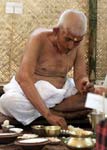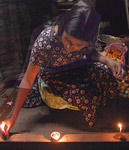| January |
MAGHE
SANKRANTI |
A
Sankranti signifies the first day of any month in the Nepali calendar year.
Makar means Capricorn. Makar Sankranti, therefore, means the first day
of the month when the sun enters that part of the zodiac which is symbolized
by Capricorn. In the Nepalese belief this day marks the division of the
Winter and Summer solstice. Bathing in rivers is prescribed for this day,
especially at the river confluence and feasting with rich foods of special
preparation is common in the family. |
| February |
MAHA
SHIVARATRI |
Shivaratri,
or the night of Lord Shiva, is observed in February-March. It is celebrated
in the honour of
Lord
Shiva. A great religious fair takes place in the Pashupatinath Temple and
thousands of people from all over Nepal and India visit it on this
occasion. |
| February |
TRIBHUVAN
JAYANTI |
The
birthday anniversary of His Late Majesty King Tribhuvan is observed throughout
the kingdom. This day is officially observed as Rashtriya Prajatantra Divas
or National Democracy Day (it generally falls on February 18) as a mark
of respect to the memory of the late king who successfully led the people's
revolution of 1950-51 . The event shared in democracy after a century of
Rana autocracy. |
| February |
SRI
PANCHAMI |
Sri
Panchami also known as Basant Panchami announces the advent of the spring
season in Nepal . On this day a religious function known as Basanta Shrawan
is held at the court-yard of Hanuman Dhoka Palace. Saraswati shrines all
over the Kingdom are filled with the crowd of school children and other
students on this day. Around the city are seen numerous wedding processions.
Saraswati temples at Swayambhu and Neel Saraswati at Gairidhara are worth
visiting during the morning. |
| March |
LOSHAR |
This
festival is most impressively observed in the month of March by all
the Tibetan speaking populations including the Sherpas. They organize
folk songs and dances on this occasion. These dances can be seen in Khumbu,
Helambu and other northern regions of Nepal and also at Bodhnath in Kathmandu. |
| March |
PHAGU
POORNIMA
 |
Phagu
Poornima also known as Holi is the festival of colour. It is observed for
eight days just before the full moon of Phalgun during which time townsmen
indulge in colour throwing at each other. This festival is observed with
most joy and gaity in the Terai region of the country. The festival is
terminated with the burning of the pole on the night preceding the Phalgun
full moon. |
| April |
GHODE
JATRA |
Ghodejatra
or the festival of horse is held on-the fourteenth of the dark half of
the Chaitra . The festival has two sides of its celebration. Its cultural
side involves the Newars of Kathmandu who celebrate it for several days.
The idols of the gods of many localities are taken in a procession in their
area in portable chariots. Horse race and acrobatic shows are presented
at this time in which His Majesty the King is present. The deities
are brought in their portable chariots. The same festival is repeated at
night in Tundikhel. |
| April |
NAVABARSH |
The
Nepalese New Year's Day usually falls in the second week of April. The
day is observed as a national holiday. The people celebrate it with great
pomp and show. On this occasion, Linga Jatra or the Bisket, as it is, it
is locally known, is held in the city of Bhadgaon. |
| April |
BAISAKH
PURNIMA |
As
Nepal is the birthplace of Lord Buddha, the Light of Asia, the triple anniversary
of the Buddha's birth, enlightenment and death 'is observed with many colourful
ceremonies on the day of Baishakh Purnima. It is a national holiday. People
celebrate the occasion with great veneration paying homage to the Buddha
at places like Swayambhunat and Lumbini. |
| April |
RED
MACHHENDRANATH
RATH
JATRA |
This
is one of the spectacular chariot festivals in Patan. It lasts for several
days in the month of April. A similar kind of chariot festival of Machhendranath
(White) is also held in Kathmandu city in the month of March-April, and
lasts usually for four days. |
| April |
MATATIRTHA
AUNSI |
This
day is observed as the Mother's Day with the expression of proper regards
towards one's mother. It is individually performed by persons out
of filial piety. Those whose mothers are already dead go to bathe
and offer ablutions to their dead mothers at Matatirtha near Thankot village.
The fortunate ones whose mothers are alive present her with gifts of sweet
meats and receive blessing from them. This day is an official holiday in
Nepal. |
April
May |
BUDDHA
JAYANTI |
Buddha
Jayanti is a great day for the Nepalese. This day which falls on
the full moon of the month of Baisakh is celebrated to commemorate the
birth, attainment of enlightement and the death of Gautama Buddha, the
founder preacher of Buddhism, more than 2500 Years ago. It is a thrice
blessed day. It is the day when Buddha was born, when he was enlightened
and when he got Nirvana (Salvation). prayers are sung and worship is offered
by the devotees in leading Buddhist shrines throughout the country including
Lumbini in the Rupandehi district, which is the birth place of Lord
Buddha,
the Light of Asia. There is a great fair held at Lumbini on this day. |
June
July |
GHANTA
KARNA |
Ghanta
Karna is also known as 'Gathyamuga'. This festival is a relic of
the be!ief in demonolatry by the people of the Valley. Ghanta Karna,
a demon and other evil spirits are propitiated and exercised on this day.
An effigy made of green reeds is erected at all the main cross-roads of
the town in the day. A person is painted in all kinds of colour till
he looks like a grotesque figure representing the demon Ghanta Karna.
This symbolic demon goes begging in the locality. At the end of the
day he is dragged to a river on the green reeds symbolising the driving
away of the demon from the locality. |







